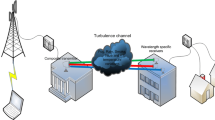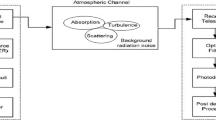Abstract
Free space optical (FSO) communication links offers an emerging alternative to RF communication links because of high speed, secure and cost-effective options to provide the last mile connectivity to end-users. They may be deployed for quick network access temporarily during link failure and natural disaster. This paper focusses on the performance of FSO communication link impaired with strong turbulence and atmospheric attenuation added through varying climatic conditions. A closed-form expression for outage probability is derived to evaluate the performance under different levels of atmospheric attenuation and turbulence strengths. The mathematical analysis clearly shows inimical effects added by atmospheric attenuation over the performance of the communication link. The impact of wavelength diversity on the outage probability of such a link is analyzed with three carrier wavelengths 1550 nm, 1310 nm and 850 nm. The simulation results with wavelength diversity for different atmospheric attenuation levels and turbulence are plotted and analyzed.











Similar content being viewed by others
References
Andrews, L. C., Phillips, R. L., Hopen, C. Y., & Al-Habash, M. A. (1999). Theory of optical scintillation. Journal of the Optical Society of America, 16(6), 1417–1429.
Andrews, L. C., & Phillips, R. L. (2005). Laser beam propagation through random media. Bellingham: SPIE Press.
Tsiftsis, T. A., Sandalidis, H. G., Karagiannidis, G. K., & Uysal, M. (2009). Optical wireless links with spatial diversity over strong atmospheric turbulence channels. IEEE Transactions on Wireless Communications, 8(2), 951–957.
Ghassemlooy, Z., Popoola, W., & Rajbhandari, S. (2012). Optical wireless communications: System and channel modelling with matlab. Boca Raton: CRC Press.
Immadi, G., Narayana, M., Kotamraju, S., & Madhuri, A. (2018). Estimating the performance of free space optical link under adverse weather conditions by using various models. Wireless Personal Communications, 103, 1603–1613.
Jasmine, S., Robinson, S., & Malaisamy, K. (2015). Investigation on free space optical communication for various atmospheric conditions. In 2015 2nd international conference on electronics and communication systems (ICECS) (pp. 1030–1034).
Kumar, N., & Sohal, H. (2014). Impact of various weather condition on the performance of free space optical communication system. Journal of Optical Communications, 0, 1–5.
Chaleshtory, Z. N., Gholami, A., Ghassemlooy, Z., & Sedghi, M. (2017). Experimental investigation of environment effects on the fso link with turbulence. IEEE Photonics Technology Letters, 29(17), 1435–1438.
Malik, A., Kumar, S., Singh, P., & Kaur, P. (2018). Performance enhancement of point-to-point FSO system under rain weather conditions. Intelligent Communication, Control and Devices, Springer nature (pp. 623–631).
Bloom, S., Korevaar, E., Schuster, J., & Willebrand, H. (2003). Understanding the performance of free space optics. Journal of Optical Networking, 2(6), 178–200.
Navidpour, S. M., Uysal, M., & Kavehrad, M. (2007). Ber performance of free-space optical transmission with spatial diversity. IEEE Transactions on Wireless Communications, 6(8), 2813–2819.
Tsiftsis, T. A., Sandalidis, H. G., Karagiannidis, G. K., & Uysal, M. (2008). Fso links with spatial diversity over strong atmospheric turbulence channels. In 2008 IEEE international conference on communications (pp. 5379–5384).
Popoola, W., Ghassemlooy, Z., Allen, J., Leitgeb, E., & Gao, S. (2008). Free-space optical communication employing subcarrier modulation and spatial diversity in atmospheric turbulence channel. Optoelectronics, IET, 2, 16–23.
Prabu, K., Cheepalli, S., & Kumar, D. S. (2014). Analysis of PolSK based FSO system using wavelength and time diversity over strong atmospheric turbulence with pointing errors. Optics Communications, 324, 318–323.
Nistazakis, H. E., & Tombras, G. (2012). On the use of wavelength and time diversity in optical wireless communication systems over gamma–gamma turbulence channels. Optics & Laser Technology, 44, 2088–2094.
Manor, H., & Arnon, S. (2002). Performance of an optical wireless communication system as a function of wavelength. In The 22nd convention on electrical and electronics engineers in Israel, 2002, (pp. 287–289).
Giggenbach, D., Wilkerson, B. L., Henniger, H., & Perlot, N. (2006). Wavelength diversity transmission for fading mitigation in the atmospheric optical communication channel. Proceedings of SPIE, 6304, 63041H–1.
Balaji, K. A., & Prabu, K. (2018). Performance evaluation of FSO system using wavelength and time diversity over malaga turbulence channel with pointing errors. Optics Communications, 410, 643–651.
Srivastava, V., Mandloi, A., & Soni, G. G. (2019). Outage probability and average BER estimation of FSO system employing wavelength diversity. Optical and Quantum Electronics, 51(7), 229.
Nema, S., Oza, S., Parmar, A., Shah, D., & Singh, S. (2019). Implementation of wavelength diversity technique in free-space optical link. Lecture Notes in Networks and Systems, Springer (pp. 241–251).
Kaur, P., Jain, V. K., & Kar, S. (2014). Performance analysis of FSO array receivers in presence of atmospheric turbulence. IEEE Photonics Technology Letters, 26(12), 1165–1168.
Shah, D., & Kothari, D. (2019). Performance analysis of free space optical link with wavelength diversity under weak and moderate turbulence conditions. Sensor Letters, 17(2), 137–143,
Farid, A. A., & Hranilovic, S. (2007). Outage capacity optimization for free-space optical links with pointing errors. Journal of Lightwave Technology, 25(7), 1702–1710.
Kim, I. I., Mcarthur, B., & Korevaar, E. J. (2001). Comparison of laser beam propagation at 785 nm and 1550 nm in fog and haze for optical wireless communications. In Proceedings of SPIE 4214.
Sousa, I., Queluz, M. P., & Rodrigues, A. (2017). An efficient visibility prediction framework for free-space optical systems. Wireless Personal Communications, 96(3), 3483–3498.
Adamchik, V. S., & Marichev, O. I. (1990). The Algorithm for Calculating Integrals of Hypergeometric Type Functions and Its Realization in REDUCE System. ISSAC ’90.
Sandalidis, H. G., Tsiftsis, T. A., Karagiannidis, G. K., & Uysal, M. (2008). Ber performance of fso links over strong atmospheric turbulence channels with pointing errors. IEEE Communications Letters, 12(1), 44–46.
Liu, C., Yao, Y., Yang, Y., Yuan, Y., Zhao, Y., & Yu, B. (2013). Performance of free-space optical communication systems using circle polarization shift keying with spatial diversity receivers. Chinese Optics Letters, 11, S20101–320104.
Author information
Authors and Affiliations
Corresponding author
Additional information
Publisher's Note
Springer Nature remains neutral with regard to jurisdictional claims in published maps and institutional affiliations.
Rights and permissions
About this article
Cite this article
Srivastava, V., Mandloi, A. & Patel, D. Analysis of Outage Probability in Wavelength Diversity Based FSO Link Under Gamma–Gamma Fading with Varying Atmospheric Attenuation. Wireless Pers Commun 116, 1933–1947 (2021). https://doi.org/10.1007/s11277-020-07772-7
Published:
Issue Date:
DOI: https://doi.org/10.1007/s11277-020-07772-7




